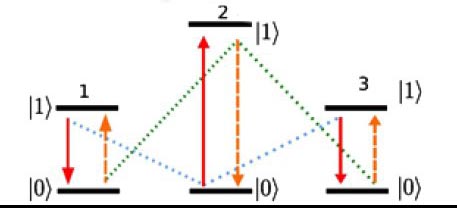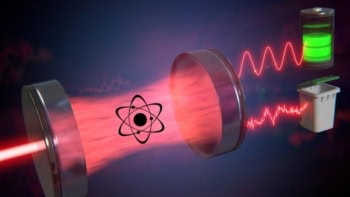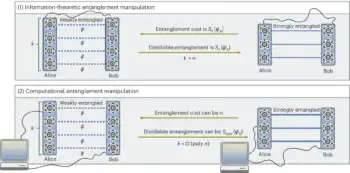
To most people a refrigerator is a cabinet full of chilled food and drink – but now a group of researchers in the UK has shown that it is possible to build a refrigerator using just two quantum particles (or even just one) in order to cool another quantum particle. They believe that such a device could be exploited in nanotechnology and that versions of it may even exist in nature.
Physicists have already built refrigerators using just a handful of atoms. However, to do so they used an external source of energy, such as a laser beam, to drive the cooling. This is equivalent to what happens inside a domestic refrigerator driven by an electric motor – both set-ups reflecting the fundamental requirement of the second law of thermodynamics that energy is needed to transfer heat from a colder to a hotter body.
The approach taken by mathematician Noah Linden and physicists Sandu Popescu and Paul Skrzypczyk of the University of Bristol is different. Rather than trying to find a practical way of building a microscopic refrigerator they instead aimed to work out how small a fridge can be in theory. They did this by showing how to remove the macroscopic external energy source and instead use three heat baths, rather than two. As Popescu explains, a domestic fridge can be considered as having two heat baths (a cold interior and a warm exterior) plus a motor, but it can also be described in terms of three heat baths, with the third, the hot bath, being used in the power station that produces the electricity.
Chilled qubits
The Bristol design comes in three varieties, one of which consists of three quantum bits, or qubits, particles that can exist only in two possible states. Two of these qubits form the refrigerator while the third is the item to be cooled. The researchers set the system up so that the combined energy of the excited states of one of the qubits from the fridge and the qubit to be cooled, say qubits one and three, is equal to that of the excited state of qubit two. With 1 representing a qubit’s excited state and 0 its ground state, this means that the system states 101 and 010 have the same energy.
Quantum mechanics dictates that if all qubits are at the same temperature these system states will have an equal probability of existing, in other words the system will continuously flip between one state and the other, spending equal amounts of time in both. Cooling qubit number three, however, means dragging it down from state 1 to state 0, or, in other words, biasing the system so that it spends more of its time in 010 than it does in 101. This, say the researchers, can be done by putting qubit one in contact with a hot bath, while qubit two is in contact with a tepid bath and qubit three is in contact with a cold one. In this way, qubit one will be forced to exist at its higher energy, i.e. in state 1, which puts the system into 101. The system is then more likely to flip from 101 to 010 than vice versa, thus cooling the third qubit to a temperature below that of its bath.
The other two fridge designs are even smaller, although a little more difficult to conceptualize. One involves a qubit and a qutrit, a quantum particle that can exist only in three possible states. Smaller still is the third possibility – a qutrit on its own. This relies on the quitrit’s three states having different spatial distributions, which means that they could in principle be in contact with three distinct heat baths. “We believe this is the smallest possible system which may be called a refrigerator,” says Linden.
Practical applications
Even though their work is purely theoretical, the researchers believe that a refrigerator based on the first of their designs could in fact be built without too much difficulty – perhaps by using three different ions held in electromagnetic fields. They say that such a fridge could be used to cool parts of nanotechnological devices such as those inside a future quantum computer, and they speculate that nature might also make use of this technology. Cooling enzymes, for example, would reduce the rate at which certain chemical reactions take place and therefore regulate processes occurring inside the body.
The Bristol team has found that their fridge can cool arbitrarily close to absolute zero, but had wondered whether it would be less efficient than macroscopic devices, in other words whether the constraint of having to use only a very limited number of quantum states would put their designs at a disadvantage. But this is not what they have found. As they report in another paper not yet published in a journal (arXiv: 1009.0865), their quantum devices can reach the Carnot efficiency – the maximum possible efficiency of any thermal machine.
Isolation is a problem
Günter Mahler of the University of Stuttgart believes the work of the Bristol researchers should stimulate “further discussions and investigations”. He describes it as an interesting piece of theoretical research but questions how easily it can be translated into working devices. In particular, he points out, the different baths would have to be kept isolated in order to avoid unwanted heat leakage. “As far as we know this would require spatial separation,” he says, “which is rather counter-productive for futuristic localized nano-devices.”
The research is described in Phys. Rev. Lett. 105 130401.



